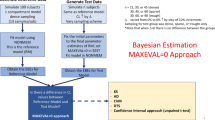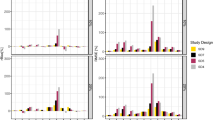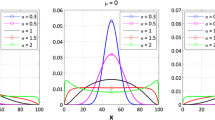Abstract
Individual pharmacokinetic parameters may change randomly between study occasions. Analysis of simulated data with NONMEM shows that ignoring such interoccasion variability (IOV) may result in biased population parameter estimates. Particular parameters affected and the extent to which they are biased depend on study design and the magnitude of IOV and interindividual variability. Neglecting IOV also results in a high incidence of statistically significant spurious period effects. Perhaps most important, ignoring IOV can lead to a falsely optimistic impression of the potential value of therapeutic drug monitoring. A model incorporating IOV was developed and its performance in the presence and absence of IOV was evaluated. The IOV model performs well with respect to both model selection and population parameter estimation in all circumstances studied. Analysis of two real data examples using this model reveals significant IOV in all parameters for both drugs and supports the simulation findings for the case that IOV is ignored: predictable biases occur in parameter estimates and previously nonexistent period effects are found.
Similar content being viewed by others
References
M. Rowland. Intra-individual variability in pharmacokinetics. In: D. D. Breimer (ed.),Towards Better Safety of Drugs and Pharmaceutical Products, Elsevier, North-Holland, 1980.
A. Grahnen. The impact of time-dependent phenomena on bioequivalence studies. In: D. D. Breimer and P. Speiser (eds.),Topics in Pharmaceutical Sciences, Elsevier, Amsterdam, 1985.
S. L. Beal and L. B. Sheiner.NONMEM Users Guides, NONMEM Project Group UCSF, San Francisco, CA, 1992.
M. Davidian and A. R. Gallant. Smooth nonparametric maximum likelihood estimation for population pharmacokinetics, with application to quinidine.J. Pharmacokin. Biopharm. 20:531–558 (1992).
A. Mallet. A maximum likelihood estimation method for random coefficient regression models.Biometrika 73:645–656 (1986).
A. Schumitzky. Nonparametric EM Algorithms for estimating prior distributions. Technical Report: 90-3, Laboratory of Applied Pharmacokinetics, USC School of Medicine, 1990.
J. W. Mandema, D. Verotta, and L. B. Sheiner. Building population pharmacokinetic-pharmacodynamic models. I. Models for covariate effects.J. Pharmacokin. Biopharm. 20:511–528 (1992).
M. O. Karlsson and U. Bredberg. Bioavailability estimation by semisimultaneous drug administration: A Monte Carlo simulation study.J. Pharmacokin. Biopharm. 18:103–120 (1990).
N. Kaniwa, N. Aoyagi, H. Ogata, and M. Ishii. Application of the NONMEM method to evaluation of the bioavailability of drug products.J. Pharm. Sci. 79:1116–1120 (1990).
D. A. Graves and I. Chang. Application of NONMEM to routine bioavailability data.J. Pharmacokin. Biopharm. 19:485–496 (1991).
P. O. Maitre, M. Buhrer, D. Thompson, and D. R. Stanski. A three-step approach combining bayesian regression and NONMEM population analysis: application to midazolam.J. Pharmacokin. Biopharm. 19:377–384 (1991).
P. A. Soons, H. C. Schoemaker, A. F. Cohen, and D. D. Breimer. Intraindividual variability in nifedipine pharmacokinetics and effects in healthy subjects.J. Clin. Pharmacol. 32:324–331 (1992).
Author information
Authors and Affiliations
Additional information
This work was supported by U.S. Department of Health and Human Services grants OM26691 and GM26676.
Rights and permissions
About this article
Cite this article
Karlsson, M.O., Sheiner, L.B. The importance of modeling interoccasion variability in population pharmacokinetic analyses. Journal of Pharmacokinetics and Biopharmaceutics 21, 735–750 (1993). https://doi.org/10.1007/BF01113502
Received:
Revised:
Published:
Issue Date:
DOI: https://doi.org/10.1007/BF01113502




